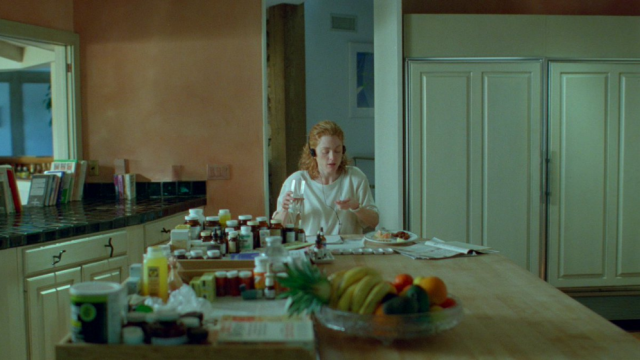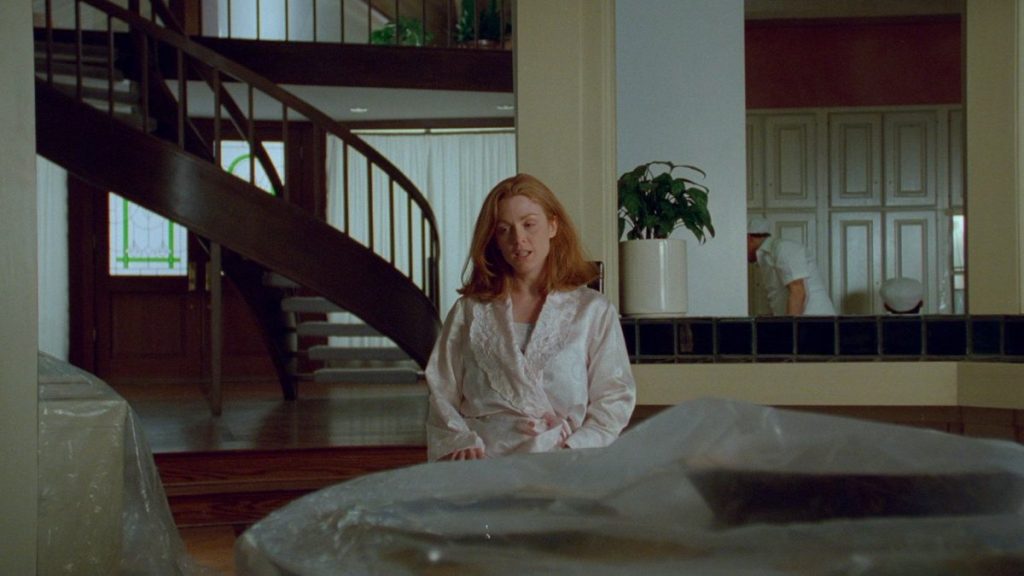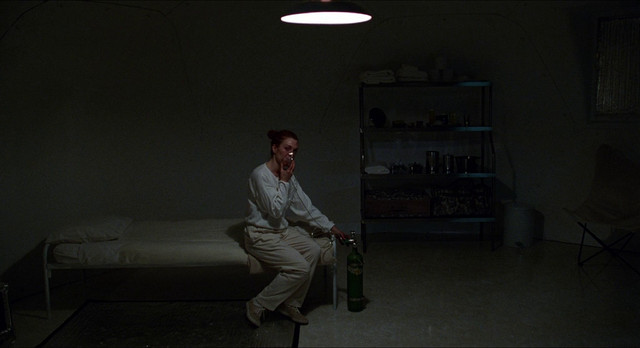Safe doesn’t exactly know what ails Carol, but writer/director Todd Haynes is keenly aware of one of her allergies: uncertainty. And like the carbon in the air and the chemicals in the water, uncertainty seems unlikely to be in short supply any time soon. And it can’t be neutralized by its exact opposite. The movie feels prescient as characters construct what they call “safe spaces” long before that became just another buzz phrase for mock debates. The movie is concerned with “toxic” elements before the word became as associated with people and situations as often as the environment. Yet at the time of its 1995 release the film was often seen as looking backwards, an allegory for the lingering fear the AIDS epidemic brought starting in the 1980s. But the film isn’t prescient or allegorical as much as simply observant. Observant of the factors that play into our health, our livelihood, and our decisions whether we acknowledge them or not.
Carol (Julianne Moore) is a suburban California homemaker, spending her days concerned with getting the right color of couch delivered, keeping social appointments, and attempting the latest fad diet. Carol resides at the center of comfortable rooms, spaces that signal of wealth and success. They’re rooms to be envied by those outside and enjoyed by the ones inside. But they’re cavernous around Carol. She’s isolated in them. Their high walls and inert furnishings loom. This is her world for the first half of the film.
One day, Carol gets sick. She feels ill more and more often, with frequent headaches, coughs, nose bleeds dizzy spells and the occasional vomit. Her sickness is a mystery. There’s special attention paid to the possible culprits: slowly sprayed perm chemicals, pervasive exhaust, an inattentive husband, a disrespectful child. At the urging of her husband Greg (Xander Berkeley) she consults with the family doctor who doubts her reports of her own symptoms and suggests the issue is psychosomatic.
She’s told the same thing – it’s all in the head – but with a smile in the film’s second half by the leader of Wrenwood, a secluded community-cum-cult for people with undiagnosed environmental illnesses like hers. The leader of this New-Agey outpost may or may not be a charlatan, and Carol arguably doesn’t get better – she develops lesions and feels affected by the highway in certain cabins. But she has a positive response to the like-minded group away from her skeptical husband and dickish doctors.
The grouchy experts and the kindly quacks have the same message: It’s All You. The methods of Wrenwood are presented as scientifically dubious at best, near parodic at times. But Carol’s embrace of the community is understandably real – who wouldn’t choose the summer camp where they remember your birthday? And it’s not like traditional medicine saved her from her symptoms. Both halves offer their own certainty, but only one offers understanding.
I very much want to push against the movie’s refusal to tip the scales in favor of the doctor and specialists. You can find professionals who aren’t rude, and if they fail, they’re probably right that it’s in your head and you should look into toughening up. But I also recognize I’m often like Greg, the surly husband who finds it easier to doubt the disease than to offer comfort in uncertainty. Shamefully, it took multiple reports from my wife on doctors that didn’t take her description of pain seriously to recognize the problem was with the man with the diploma on the wall.
And at the same time, I’m sympathetic to Carol when the flyer that starts her journey to Wrenwood catches her eye: “Are You Allergic to the 20th Century?” Yes, I am, and the new 21st variant, too. Allergic to environmental erosion, to war, to income inequality. To that feeling that I’m powerless to do anything about these things, yet still responsible for my contributions to their continuation. To uncertainty.
Even when I’m in the straight, perfect lines of my home I’m keenly aware of the chaos of the 21st century buzzing around me. The soundtrack of the first half of Safe is a near-constant hum of refrigerator condensers, traffic, and HVAC systems. The 2000s have added droning computer fans and phone notification buzzes, not to mention the invisible wi-fi and data flowing through us at all times. Bad news travels through our skin, into our lungs. The truck spewing fumes is putting the coasts underwater. The food on our plates was brought to us by that truck. Communities with comfortable explanations are closer at hand than ever. Can someone be blamed for setting up with them when uncertain exploration has brought us to this? But the COVID-19 pandemic taught us the consequences of giving an inch to science skepticism, and if enforcing the logical means trampling the emotional, maybe it has to be that way.
I feel inadequate in my expression of this, and again I am Carol. After her birthday dinner and dance Carol gets the chance to make a speech in front of her new, supportive friends and this is when we’d expect the film to give voice to its observations on These Modern Times. But Carol blows it. The film slowly dollies in on a halting and meandering slobber of nonsense. She stumbles to a stop before polite applause. This instead is the film’s thesis on the sickness of modern times. Maybe failing to articulate the problem is preferable to ignoring it entirely.
There’s a character at the margins of the second half of the movie (and featured in many of the promotion images) who struts around the compound covered head-to-toe in protective gear. There’s a hint that the logical yet absurd end to the Wrenwood prescription of self-reliance is this kind of distrust and isolationism. But Carol doesn’t seem to be on this path because as often as she’s listening to the camp’s leader espouse self-reliance, she’s comparing plights with other campers and flirting with another camper who playfully signs up for volunteer shifts with her and makes her laugh. These are symptoms she didn’t find in her modern life.
In contrast with the straight, perfect lines of her home, the end of the film finds Carol under the curved arch of her Wrenwood yurt, the most secluded structure of this secluded community. Just as alien as the perfect home she lived in at the beginning, but a more personal kind of alien. Here she confronts her own reflection. “I love you,” she tells it, her face impassive. This act of self-affirmation was suggested to her earlier in the film, not by an expert, not by a guru. By a friend.




